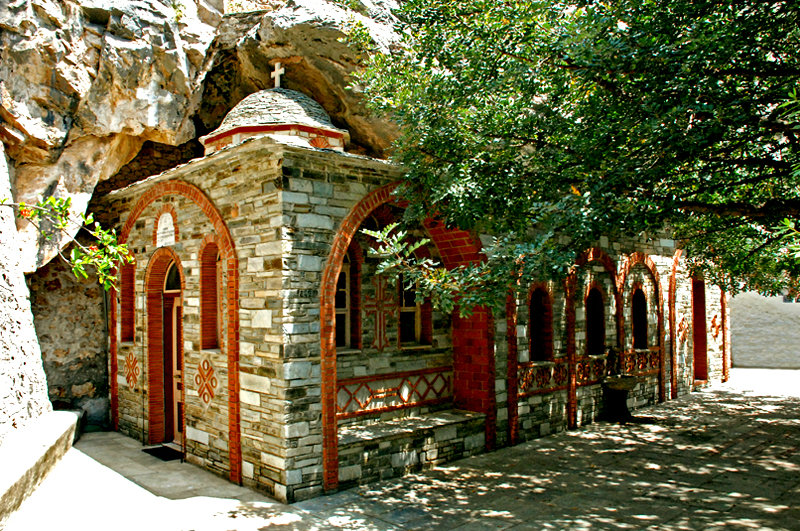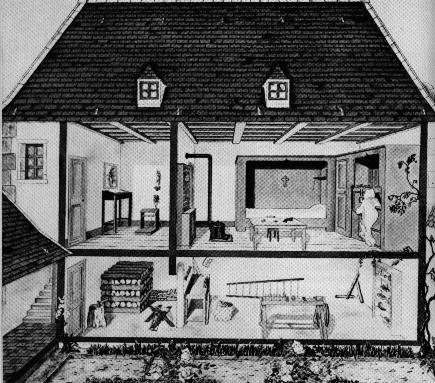|
Skete Of Saint Anne
The Skete of St Anne is a dependent idiorrhythmic ( hermitage-style) skete, a monastic community attached to the more formalised Great Lavra Monastery in Mount Athos, Greece. It lies on the shore of the Aegean Sea about 800 metres from the New Skete. The hamlet of Vouleftiria is located in the lower (western) part of the skete. History The ''kyriakon'' (central church) of the Skete of Saint Anne was built in 1680 when the skete was being enlarged by Patriarch Dionysius III of Constantinople. List of cells List of cells and other buildings in Agia Anna Skete: Notable people * Cyril V of Constantinople Cyril V Karakallos ( el, ), (? – 27 July 1775) was Ecumenical Patriarch of Constantinople for two periods from 1748 to 1751 and from 1752 to 1757. A controversial figure, often blamed for his ideas about the baptism, in 1755 he issued the ''O ... * Nicodemus of Elbasan Namesakes '' Centaurea sanctae-annae'', a species of knapweed, is named after the skete. Furt ... [...More Info...] [...Related Items...] OR: [Wikipedia] [Google] [Baidu] |
Greek Orthodox
The term Greek Orthodox Church (Greek language, Greek: Ἑλληνορθόδοξη Ἐκκλησία, ''Ellinorthódoxi Ekklisía'', ) has two meanings. The broader meaning designates "the Eastern Orthodox Church, entire body of Orthodox (Chalcedonian) Christianity, sometimes also called 'Eastern Orthodox,' 'Greek Catholic,' or generally 'the Greek Church. The narrower meaning designates "any of several Autocephaly, independent churches within the worldwide communion of Eastern Orthodoxy, [Eastern] Orthodox Christianity that retain the use of the Greek language in formal ecclesiastical settings". Etymology Historically, the term "Greek Orthodox" has been used to describe all Eastern Orthodox churches, since the term "Greek" can refer to the heritage of the Byzantine Empire. During the first eight centuries of Christian history, most major intellectual, cultural, and social developments in the Christian Church took place in the Byzantine Empire or its Byzantine commonwealth, sphe ... [...More Info...] [...Related Items...] OR: [Wikipedia] [Google] [Baidu] |
Mikra Agia Anna-Spilaio 02 , also known as Asia Minor (Μικρά Ἀσία, ''Mikrá Asía'', 'small Asia')
{{Disambiguation ...
Mikra may refer to: *Mikra, Thessaloniki, a town in the Thermi municipality, Greece *''Mikra'', or Tanakh, the canonical collection of Jewish texts See also * *Micra (other) *Mikro (other) *Micro (other) *Anatolia Anatolia, tr, Anadolu Yarımadası), and the Anatolian plateau, also known as Asia Minor, is a large peninsula in Western Asia and the westernmost protrusion of the Asian continent. It constitutes the major part of modern-day Turkey. The re ... [...More Info...] [...Related Items...] OR: [Wikipedia] [Google] [Baidu] |
Knapweed
''Centaurea'' () is a genus of over 700 species of herbaceous thistle-like flowering plants in the family Asteraceae. Members of the genus are found only north of the equator, mostly in the Eastern Hemisphere; the Middle East and surrounding regions are particularly species-rich. In the western United States, yellow starthistles are an invasive species. Around the year 1850, seeds from the plant had arrived to the state of California. It is believed that those seeds came from South America. Common names Common names for this genus are centaury, centory, starthistles, knapweeds, centaureas and the more ambiguous "bluets"; a vernacular name used for these plants in parts of England is "loggerheads" (common knapweed). The ''Plectocephalus'' group – possibly a distinct genus – is known as basketflowers. "Cornflower" is used for a few species, but that term more often specifically means either '' C. cyanus'' (the annual cornflower) or ''Centaurea montana'' (the perennial c ... [...More Info...] [...Related Items...] OR: [Wikipedia] [Google] [Baidu] |
Centaurea Sanctae-annae
''Centaurea'' () is a genus of over 700 species of herbaceous thistle-like flowering plants in the family Asteraceae. Members of the genus are found only north of the equator, mostly in the Eastern Hemisphere; the Middle East and surrounding regions are particularly species-rich. In the western United States, yellow starthistles are an invasive species. Around the year 1850, seeds from the plant had arrived to the state of California. It is believed that those seeds came from South America. Common names Common names for this genus are centaury, centory, starthistles, knapweeds, centaureas and the more ambiguous "bluets"; a vernacular name used for these plants in parts of England is "loggerheads" (common knapweed). The ''Plectocephalus'' group – possibly a distinct genus – is known as basketflowers. "Cornflower" is used for a few species, but that term more often specifically means either '' C. cyanus'' (the annual cornflower) or ''Centaurea montana'' (the perennial c ... [...More Info...] [...Related Items...] OR: [Wikipedia] [Google] [Baidu] |
Nicodemus Of Elbasan
The new martyr Nicodemus also known as Saint Nicodemus of Berat (Albanian: ''Shën Nikodhimi i Beratit'') was born in Vithkuq in present-day Albania. He was married and had children there. Later he converted to Islam and then became a Christian again, at Mount Athos, Greece. After three years he decided to return in his native town, informing the Muslim authorities of his decision. He was beheaded on 11 July 1722. His relics are venerated in Berat.Great Synaxaristes: Ὁ Ἅγιος Νικόδημος ὁ νέος Ὁσιομάρτυρας ἀπὸ τὸ Ἐλβασᾶν'' 11 ΙΟΥΛΙΟΥ. ΜΕΓΑΣ ΣΥΝΑΞΑΡΙΣΤΗΣ. Life The secular name of Nicodemus was Nikolla Dede, and he was originally from Vithkuq, Korça. He lived in Berat, where he practiced tailoring. He had been married four times and his fourth wife was a Muslim, so he converted for her sake. The first son, who was in adulthood, refused to convert, so he left home and settled in the Holy Mountain. When he lear ... [...More Info...] [...Related Items...] OR: [Wikipedia] [Google] [Baidu] |
Cyril V Of Constantinople
Cyril V Karakallos ( el, ), (? – 27 July 1775) was Ecumenical Patriarch of Constantinople for two periods from 1748 to 1751 and from 1752 to 1757. A controversial figure, often blamed for his ideas about the baptism, in 1755 he issued the ''Oros'', a canonical document which, superseding the previous use of accepting Christian converts by Chrismation, stated that all non-Orthodox (including Catholic) baptisms were not valid and all converts needed to be re-baptized. Life Cyril was born in Dimitsana, in the Peloponnese. Still young, he was taken captive during the Ottoman–Venetian War (1714–1718) and after his release he went to Patmos where he became a monk. In Patmos he also continued his studies but he was expelled by the school for behavior issues before graduation. In 1737 he was appointed Metropolitan of Meleniko and in 1745 he was promoted to the See of Nicomedia. On 28 September 1748 he was elected Patriarch of Constantinople for the first time in place of Pai ... [...More Info...] [...Related Items...] OR: [Wikipedia] [Google] [Baidu] |
Monastic Cell
A cell is a small room used by a hermit, monk, nun or anchorite to live and as a devotional space. Cells are often part of larger cenobitic monastic communities such as Catholic and Orthodox monasteries and Buddhist vihara, but may also form stand-alone structures in remote locations. The word ''cell'' comes from the Old French ''celle'' meaning a monastic cell, itself from the Latin meaning "room", "store room" or "chamber". In Christianity Usually, a cell is small and contains a minimum of furnishings. It may be an individual living space in a building or a hermit's primitive solitary living space, possibly a cave or hut in a remote location. A small dependent or daughter house of a major monastery, sometimes housing just one or two monks or nuns, may also be termed a cell. The first cells were in the Nitrian Desert in Egypt following the ministry of Paul of Thebes, Serapion, and Anthony the Great.Chryssavgis, John; Ware, Kallistos; Ward, Benedicta, ''In the Heart of the Des ... [...More Info...] [...Related Items...] OR: [Wikipedia] [Google] [Baidu] |
Dionysius III Of Constantinople
Dionysius III was the Ecumenical Patriarch of Constantinople from June 29, 1662 to October 21, 1665. He had previously been bishop of Thessaloniki, Larissa (1652–1662) and Bursa.Venance Grumel, ''Traité d'études byzantines'', « I. La Chronologie », Presses universitaires de France, Paris, 1958, p. 438. References Sources * Venance Grumel Venance Grumel (born François Grumel on 23 May 1890, La Serraz, Le Bourget-du-Lac, Savoy, France – died 13 August 1967, Paris) was a French theologian and Byzantinist. Biography He was born on 23 May 1890 under the name of François Grume ..., ''Traité d'études byzantines'', « I. La Chronologie », Presses universitaires de France, Paris, 1958. {{authority control Bishops of Thessaloniki Bishops of Larissa Metropolitans of Bursa 17th-century Ecumenical Patriarchs of Constantinople People from Andros 17th-century Greek clergy 1696 deaths ... [...More Info...] [...Related Items...] OR: [Wikipedia] [Google] [Baidu] |
Vouleftiria
Vouleftiria ( el, Βουλευτήρια) is an area of Mount Athos that belongs to the Monastery of Great Lavra. Located directly downhill from the main area of the Skete of Saint Anne, it is served by the port (''arsanas'') of Saint Anne (Agia Anna) ( el, Aρσανάς Αγίας Άννας, translit=Arsanas Agias Annas). There are several ''kellia Kellia ("the Cells"), referred to as "the innermost desert", was a 4th-century Egyptian Christian monastic community spread out over many square kilometers in the Nitrian Desert about 40 miles south of Alexandria. It was one of three centers of ...'' in Vouleftiria. References Populated places in Mount Athos Great Lavra {{CentralMacedonia-geo-stub ... [...More Info...] [...Related Items...] OR: [Wikipedia] [Google] [Baidu] |
Mount Athos
Mount Athos (; el, Ἄθως, ) is a mountain in the distal part of the eponymous Athos peninsula and site of an important centre of Eastern Orthodox monasticism in northeastern Greece. The mountain along with the respective part of the peninsula have been governed as the monastic community of Mount Athos, an autonomous region within the Hellenic Republic, ecclesiastically under the direct jurisdiction of the Ecumenical Patriarch of Constantinople, while the remainder of the peninsula forms part of the Aristotelis municipality. Mount Athos has been inhabited since ancient times and is known for its long Christian presence and historical monastic traditions, which date back to at least AD 800 and the Byzantine era. Because of its long history of religious importance, the well-preserved agrarian architecture within the monasteries, and the preservation of the flora and fauna around the mountain, Mount Athos was inscribed on the UNESCO World Heritage List in 1988. In modern Greek, ... [...More Info...] [...Related Items...] OR: [Wikipedia] [Google] [Baidu] |
New Skete (Mount Athos)
New Skete or Nea Skiti ( el, Νέα Σκήτη or Σκήτη Εισοδίων της Θεοτόκου ή Νέα Σκήτη) is one of two Orthodox Christian sketes of Agiou Pavlou Monastery in the monastic state of Mount Athos. It lies on the Aegean sea shore between Agiou Pavlou Monastery (monastery of Saint Paul) and the Skete of Saint Anne, on the southwestern side of the peninsula of Athos (a 30-minute walk from Agiou Pavlou). It belongs administratively to the Skete of Saint Anne. Overview The New Skete speaks Greek, follows the idiorrhythmic way of monastic life, and is inhabited by about 40 monastics living in about 33 residences. The Skete is built on the steep and rocky side of Mount Athos. The monastics support themselves by painting icons and cultivating olive trees and other small-scale agricultural products. Religious memorabilia, books, and other items are available for purchase on New Skete'website The Skete is in possession of some 200 ancient manuscripts ... [...More Info...] [...Related Items...] OR: [Wikipedia] [Google] [Baidu] |




